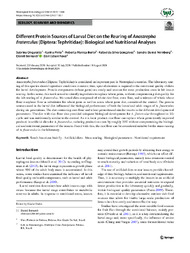Different Protein Sources of Larval Diet on the Rearing of Anastrepha fraterculus (Diptera: Tephritidae): Biological and Nutritional Analyses.
Different Protein Sources of Larval Diet on the Rearing of Anastrepha fraterculus (Diptera: Tephritidae): Biological and Nutritional Analyses.
Author(s): ONGARATTO, S; PINTO, K.; MANICA?BERTO, R.; GONÇALVES, R. da S.; NÖRNBERG, S. D.; BERNARDI, D.; NAVA, D. E.
Summary: Abstract: Anastrepha fraterculus (Diptera: Tephritidae) is considered an important pest in Neotropical countries. The laboratory rearing of this species should reproduce conditions in nature; thus, special attention is required to the nutritional quality of diets for larval development. Protein components (wheat germ) are costly and account for most production costs in lab insect rearing. In this sense, this work aimed to identify ingredients to replace wheat germ, without compromising diet quality for the lab rearing of A. fraterculus. We tested diets composed of whole rice four, corn four, and a mixture of whole wheat four+soybean four as substitutes for wheat germ as well as a raw wheat germ diet, considered the control. The protein sources used in the larval diet infuenced the biological performance of both the larval and adult stages of A. fraterculus during six generations. The diet containing corn four and wheat germ showed similar results in the diferent developmental parameters. The diet with rice four also provided adequate biological development for A. fraterculus throughout its life cycle and was nutritionally similar to the control. As it is local product, rice four can replace wheat germ (costly imported product) in artifcial diets for A. fraterculus, reducing production costs by roughly 30% without compromising the biological and nutritional parameters of the insects. Faced with this, the rice four can be considered suitable for the mass rearing of A. fraterculus in the laboratory.
Publication year: 2024
Types of publication: Journal article
Observation
Some of Embrapa's publications are published as ePub files. To read them, use or download one of the following free software options to your computer or mobile device. Android: Google Play Books; IOS: iBooks; Windows and Linux: Calibre.
Access other publications
Access the Agricultural Research Database (BDPA) to consult Embrapa's full library collection and records.
Visit Embrapa Bookstore to purchase books and other publications sold by Embrapa.

